The Apple Thunderbolt Display Review
by Anand Lal Shimpi on September 23, 2011 2:56 AM EST- Posted in
- Displays
- Mac
- Apple
- Thunderbolt
- Thunderbolt Display
Ever since I moved to a notebook as my main work computer I've become increasingly annoyed with the process of actually moving my notebook-as-a-desktop around. At my desk I've got DisplayPort, Ethernet, two USB, FireWire 800, speakers and power all plugged into a 15-inch MacBook Pro. What makes it frustrating isn't the first-world-problem of having to unplug seven cables, rather that it doesn't need to be seven cables - Apple could make the whole thing happen with just two.
Every Mac released in 2011 has at least one Thunderbolt port (the iMac has two), and Thunderbolt can deliver exactly what I'm looking for. Thunderbolt can carry two things: PCI Express and DisplayPort, the former for data and the latter obviously for video. Why would you want to carry PCIe and DP over a single cable? To address problems like the one above.
Pretty much all device expansion on modern day PCs happens via PCI Express. Several years ago it was hard to find PCIe sound cards or Ethernet controllers, but these days vanilla PCI slots are nearing extinction and PCIe is the de facto standard. Ethernet, USB and FireWire controllers all exist as single-lane PCIe devices. Put a bunch of them at the other end of a Thunderbolt cable and you no longer need to plug in a bunch of individual cables into your notebook when at your desk. Send DisplayPort over the same cable and you can actually move all of those ports onto your monitor, thereby using a single cable to carry everything but power to your display. And this is exactly what Apple has done with its new Thunderbolt Display. By mating its 27-inch LED Cinema Display with a bunch of integrated IO controllers, Apple is hoping to deliver a display that's more of a mobile docking station than just a passive way to display video.
Apple has tried this in the past. The old Cinema Displays used to feature an Apple Display Connector (ADC) that actually carried DVI, USB and power from a desktop Mac to the monitor. You only needed to plug in a single cable to your display, significantly reducing desktop clutter. Although Thunderbolt does carry power, it's limited to 10W - not enough to power any reasonably sized display. Where Thunderbolt does win out over ADC however is in its universal appeal. Intel created the standard. Although it's used almost exclusively on Apple systems today, come 2012 Intel is expecting PC OEMs to embrace the interface with its Cactus Ridge line of Thunderbolt controllers.

Apple's Thunderbolt Display
The Thunderbolt Display uses a near, if not perfectly, identical panel to what was in last year's 27-inch LED Cinema Display. You get a 27-inch, 16:9, 2560 x 1440 LED backlit display capable of at least 350 nits at full brightness. Apple seems to conservatively spec its desktop displays as we were able to measure 425 nits at max brightness. The uber brightness comes in handy because the display does have a glossy finish. Indoors it's not really a problem unless you're watching a dark movie scene with the display lit by a sun-facing window. Even then, cranking up the brightness all the way is usually enough to overcome any significant glare. As with all glossy displays, if you have light control (e.g. curtains or blinds) you'll be just fine.
The similarities don't end with the internal panel, the chassis is very similar to its older sibling and the Thunderbolt Display retails for the same $999 price.
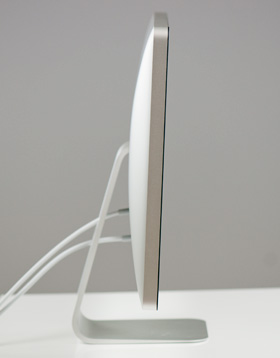 |
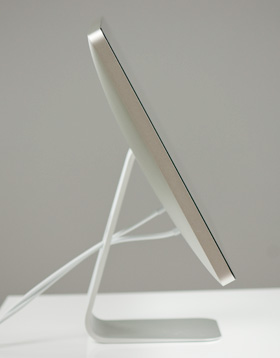 |
The display sits on an aluminum swivel base that allows for -5 degrees to 25 degrees of tilt along the horizontal axis. There's no height adjustment for the display either, only tilt. Personally, I use a height adjustable desk as I find it helps me avoid any carpal tunnel pain. Combined with a height adjustable chair, the lack of height adjustment on the display doesn't bother me. If you have a fixed height desk however, this may be a problem.
Aesthetically the Thunderbolt Display continues Apple's aluminum meets glass design language. The front of the display is all glass, while the edges and back are all aluminum. Along the top surface of the display is a mic for the integrated FaceTime HD camera. The outgoing 27-inch LED Cinema Display (still available for purchase online) sported a 640 x 480 camera, while the Thunderbolt Display ups capture resolution to 1280 x 720.
There's an ambient light sensor hidden in the top bezel of the display, but as always you can disable its functionality from within OS X.

There are two integrated speakers in the display, again unchanged from the previous LED Cinema Display.
Two cables attach directly to the display: a removable power cable and an integrated IO cable. Cable management is done through a round cutout in the aluminum stand. The IO cable is where things really change with the Thunderbolt Display. Instead of a breakout of three cables as was the case with the Cinema Display, there are now only two: MagSafe and Thunderbolt.
The MagSafe connector remains unchanged. If you've got any Mac that can be charged by an 85W MagSafe adapter, the Thunderbolt Display will charge said Mac. This feature alone is particularly awesome for notebook-as-a-desktop users since it allows you to just keep your actual AC adapter tucked away in your travel bag. For me I keep my MagSafe adapter in my bag and never take it out so I never have to worry about forgetting to pack it. Given how expensive MagSafe adapters are ($79 for an 85W), this is a nice feature for MacBook Air/Pro owners.
The Thunderbolt cable is obviously what gives this new display its name. Inside the Thunderbolt Display is an Intel Light Ridge Thunderbolt controller. The type of controller is important as it bestows upon the display some clear limitations. The biggest of course is the lack of support for all non-Thunderbolt systems. That's right, the only way to get video to the Thunderbolt Display is by using a Thunderbolt enabled Mac (or theoretically a Thunderbolt enabled PC). For Mac users that means only 2011 MacBook Pro, Air, iMac or Mac mini models will work with the Thunderbolt Display. Everyone else has to either buy a new Mac or stick with older displays.
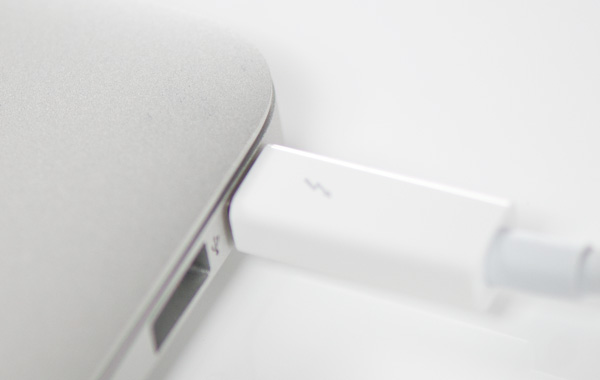
I believe the limitation here is actually on the cable side. A Thunderbolt cable can only transmit a Thunderbolt signal. Although DisplayPort is muxed in, if the display on the other end is expecting Thunderbolt and it receives DisplayPort it won't know what to do with it. It's possible Apple could have built in logic to autosense and switch between Thunderbolt and DisplayPort as inputs, but Apple traditionally employs clean breaks rather than long technology transitions. If Apple wants to ensure Thunderbolt gets adopted (at least by its users), this is the way to do it. As we learned from other legacy interfaces (e.g. PS/2, IDE), if you enable backwards compatibility you'll ensure the survival of systems that implement those interfaces. It's not so great for existing customers unfortunately.


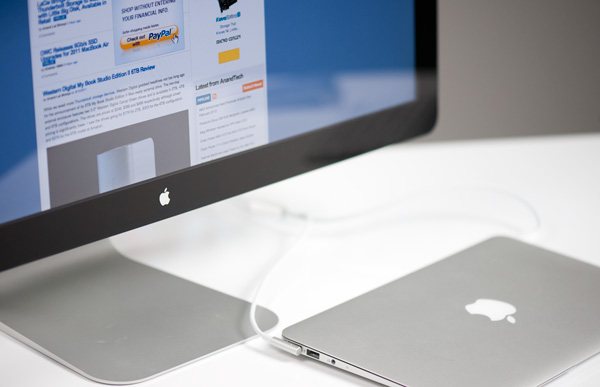
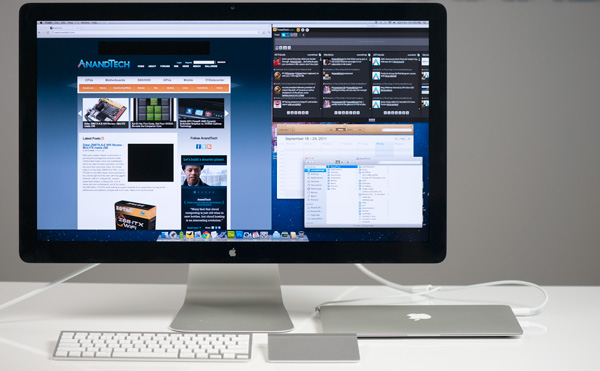
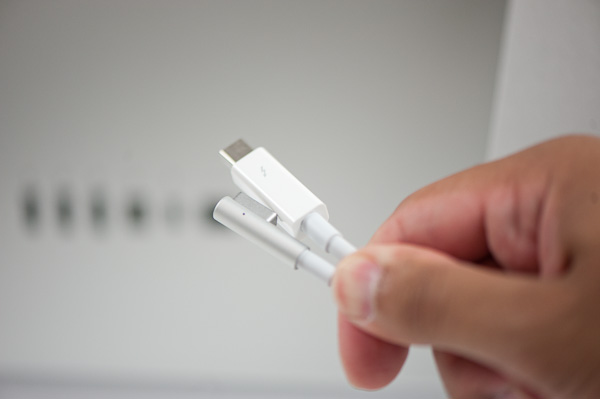








275 Comments
View All Comments
MobiusStrip - Friday, September 23, 2011 - link
I wish someone would have the balls to step up and end this moronic glossy-screen fad.Glossy sucks in all lighting conditions. It doesn't matter where the illumination is coming from in the room, or even if there IS any. At the very least, the light from the monitor is going to illuminate YOU, putting your reflection over those supposedly "deep blacks" and "rich colors." Glossy screens work for one customer: the ninja in the closet.
Going from a glossy screen to matte is like cleaning a filthy windshield: You wonder how you put up with it until that moment.
retrospooty - Friday, September 23, 2011 - link
"Glossy screens work for one customer: the ninja in the closet."At the risk of outing my secret identity, we closet Ninja's reject your claim!
Colorblinded - Friday, September 23, 2011 - link
You and me both. I can tolerate it on my phone but my desktop or laptop are matte only.HMTK - Friday, September 23, 2011 - link
++That and widescreen resolutions. Gimme a 4:3 high res matte screen anyday!
Constructor - Friday, September 23, 2011 - link
Well, 16:9 with a 2560-pixel display still gives me 1440 pixels vertically, surpassed only by the 1600 in a 16:10 30" panel which costs double the price and significantly more than in any of the smaller resolutions.So I can live quite comfortably with my iMac 27" (same panel as in the TBD). "Suffering" on a very high level, so to speak. 8-)
doubledeej - Sunday, September 25, 2011 - link
I've always felt like integrated monitors are a waste. The trouble with iMacs (and all All-in-Ones) is that you have to buy your monitor over and over again each time you buy a computer. So ~$800 of your computer's price went toward getting that 27" monitor, and when your computer dies, so does your display, and that money is lost.I've been using the same four high-end LCDs for my last three computers. I'll gladly spend $500/yr to ensure I have the latest and greatest computer without having to invest an additional dime in new displays.
Constructor - Sunday, September 25, 2011 - link
Macs generally life for many years. Actually, none of mine has ever "died". Even my first one from the early 1990s still works as on the first day.Plus, recent iMacs can serve as external monitors for other computers.
Maybe you're just switching your computers a little frantically compared to most other people. My Macs have so far been in productive use for 5-6 years each and are just mostly collecting dust since retirement because I chose not to sell them to someone who could get good use out of them even after that.
This is my first iMac. I'll see whether I'll keep it around as a monitor for its successor or if I'll just sell it off when the time comes. It's a pretty good concept, however, and it works very well in practice.
jecs - Friday, September 23, 2011 - link
I am stepping up (balls?) but to say you think you know what you are talking about but you are not.The thunderbolt display is a high end consumer display not a professional level display.
Even the Dell 2711 is an entry professional monitor. Dell Is better suited for color correction and wide color gamut space but not the real broadcast deal.
Where, where in a broadcast professional production environment would you even consider an Apple display? Maybe on press production for everyday news or on production studios for independent production on constrained budgets who don't depend on critical wide color gamut.
80% of consumers and most professional not working on critical color correction don't care for mate screens. Glossy screens are better for watching a movie or content and in a controlled environment this is acceptable.
name99 - Friday, September 23, 2011 - link
"The thunderbolt display is a high end consumer display not a professional level display.""Where, where in a broadcast professional production environment would you even consider an Apple display?"
If only there were professions OTHER than "broadcast professional"...
But sadly we live in a world where every professional is a broadcast professional, and clearly Apple has screwed up in making a device that appeals to print workers, or programmers, or musicians. None of them, after all, are professionals...
jecs - Saturday, September 24, 2011 - link
80% of people buying from Apple opted for glossy screens, this is a fact. The 20% that opted for mate screens still have the "optional antiglare display" in 15-17 Mac book Pros.Now, photographers, programers, musicians or other professional working with a "Mac Pro" have great options from other very well recognized vendors like LaCie, NEC, EIZO, HP, Dell and others.
Apple as well as Dell have always been a cheap competitive alternative for higher end displays but never the best dedicated option for professionals who depend on the most accurate screen.
The only ones abandoned are the casual, or entry level professionals that got use to working with Apple displays and some high end aficionados. That is true, but those could buy today a LaCie Monitor for around $950.
I don't know, Apple could launch a mate display line whenever they see the opportunity, but they appear not seeing a good one in the present. Maybe they don't consider the number of professionals buying from Apple enough to produce more mate displays.
Cheer up!